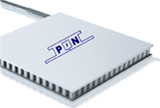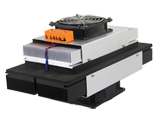Resource > Technical Guidline
Thermoelectric-Module-Options
author:P&N Tech Time :
2016-08-02 browse:628
1. Module Thickness Tolerance Options: Generally ±0.2mm, custom options are listed below,
A. ±0.2mm;
B. ±0.1mm;
C. ±0.05mm;
D. ±0.025mm;
E. ±0.015mm。
2. Module Moisture Protection Options: Generally seal with white RTV silicone. Maximum ΔT value is reduced by 2-3°C for silicone and by 1-2°C for epoxy sealing versions. Custom options are listed below,
A. No seal;
B. White RTV silicone;
C. Translucent silicone;
D. Black epoxy.
3. Module Wires Options: Generally wire length is 150mm. Custom options are list below,
A. No wires;
B. 150mm;
C. Up to customers’ requirement;
D. Special Terminals.
4. Ceramic External Substrate Surface Options: Generally bare ceramic surface, custom options are list below,
A. Bare Ceramic surface;
B. Metallized surface (Gold, Nickel or Copper);
C. Specific metal thickness;
D. One side metallization only;
E. Pre-Tinning Options.
5. Ceramic can choose different thickness Alumina or Aluminum Nitride.
A. ±0.2mm;
B. ±0.1mm;
C. ±0.05mm;
D. ±0.025mm;
E. ±0.015mm。
2. Module Moisture Protection Options: Generally seal with white RTV silicone. Maximum ΔT value is reduced by 2-3°C for silicone and by 1-2°C for epoxy sealing versions. Custom options are listed below,
A. No seal;
B. White RTV silicone;
C. Translucent silicone;
D. Black epoxy.
3. Module Wires Options: Generally wire length is 150mm. Custom options are list below,
A. No wires;
B. 150mm;
C. Up to customers’ requirement;
D. Special Terminals.
4. Ceramic External Substrate Surface Options: Generally bare ceramic surface, custom options are list below,
A. Bare Ceramic surface;
B. Metallized surface (Gold, Nickel or Copper);
C. Specific metal thickness;
D. One side metallization only;
E. Pre-Tinning Options.
5. Ceramic can choose different thickness Alumina or Aluminum Nitride.







